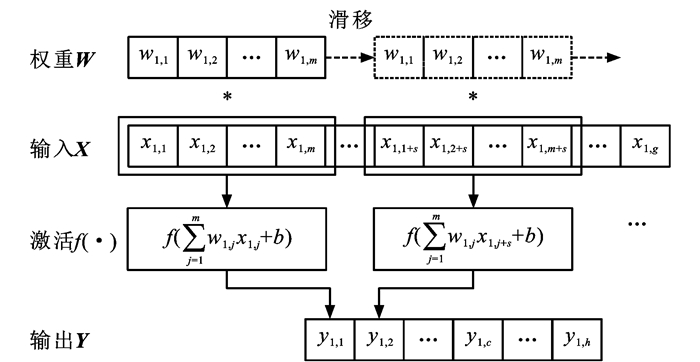Damage detection for floating-slab track steel-spring based on residual convolutional network
-
摘要: 针对传统故障诊断方法难以有效检测浮置板轨道钢弹簧损伤这一挑战性问题,提出了一种基于一维残差卷积网络的损伤检测方法;建立了车辆-浮置板轨道耦合动力学模型,得到了多种工况下列车通过导致的浮置板振动响应数据集;利用残差卷积网络对不同损伤情形下的振动响应进行特征提取和数据分类,实现了对损伤钢弹簧的准确定位;研究了残差卷积网络在不同传感器布置方案上的检测性能,分析了损伤钢弹簧和传感器之间的复杂位置关系对检测性能的影响规律,优化并确定了经济可靠的传感器布置方案。研究结果表明:传感器的位置越靠近浮置板中部,残差卷积网络对不同损伤情形下的数据分类准确性和鲁棒性越好;传感器的布置数量增多,损伤检测方法的性能也随之改善,但传感器过多地集中于浮置板中部并不会带来显著的性能提升;在浮置板中部的钢弹簧损伤比在浮置板端部的钢弹簧损伤更难识别;损伤检测方法在全覆盖式布置方案下达到了99.11%的分类准确率,对复杂多变的检测情景具有良好适应性,而优化后双传感器布置方案和三传感器布置方案的分类准确率分别达到了98.23%和98.96%,优化后传感器布置方案具有良好的检测性能,同时也保持了损伤检测方法对复杂情景的适应性。Abstract: As traditional fault diagnosis methods can hardly effectively detect the steel-spring damage of floating-slab track (FST), a damage detection method based on the one-dimensional residual convolutional network was proposed. A vehicle-FST coupled dynamics model was built, and the data sets for the floating-slab vibration response caused by the passing vehicles under various conditions were generated. The residual convolutional network was utilized for the feature extraction and data classification of the vibration response under different damage scenarios to achieve the accurate positioning of damaged steel springs. The detection performance of the residual convolutional network on different sensor deployment schemes were studied. The influence of the complex positional relationship between the damaged steel springs and the sensors on the detection performance was analyzed, and the economic and reliable sensor deployment schemes were optimized and determined. Analysis results reveal that when the sensors are closer to the middle of the floating-slab, better classification accuracy and robustness of the residual convolutional network can be achieved on the data under different damage scenarios. As the number of sensors increases, the detection performance of the method also improves, but the excessive concentration of the sensors in the middle of the floating-slab will not bring about significant improvement on the performance. The damage of steel-springs in the middle of the floating-slab is more difficult to identify than that at the end of the floating-slab. The damage detection method achieves a classification accuracy of 99.11% on the full-coverage deployment scheme, boasting good adaptability to complex and changeable detection scenarios. The classification accuracies of the optimized two-sensor deployment scheme and three-sensor deployment scheme reach 98.23% and 98.96%, respectively. The optimized sensor deployment schemes have good detection performance and keep the adaptability of the damage detection method to complex scenarios. 4 tabs, 16 figs, 30 refs.
-
表 1 混淆矩阵
Table 1. Confusion matrix
预测类别 真实标签 损伤 正常 损伤 真实损伤A1 伪报损伤A2 正常 伪报正常A3 真实正常A4 表 2 浮置板轨道参数
Table 2. Parameters of floating-slab track
轨道结构 参数 数值 钢轨 弹性模量/MPa 2.1×105 截面惯性矩/m4 3.217×10-5 单位长度质量/(kg·m-1) 60.64 扣件系统 垂向刚度/(N·m-1) 3.0×107 垂向阻尼/(N·s·m-1) 2.5×104 扣件间距/m 0.6 轨道板 长度/m 6 弹性模量/MPa 3.65×104 截面惯性矩/m4 0.035 质量/kg 25 750 钢弹簧隔振器 垂向刚度/(N·m-1) 7.0×106 垂向阻尼/(N·s·m-1) 1.4×105 钢弹簧间距/m 1.2 表 3 传感器布置方案
Table 3. Sensors deployment schemes
方案编号 单传感器布置点 双传感器布置点 三传感器布置点 1 S1 S1、S17 S1、S9、S17 2 S2 S2、S16 S2、S9、S16 3 S3 S3、S15 S3、S9、S15 4 S4 S4、S14 S4、S9、S14 5 S5 S5、S13 S5、S9、S13 6 S6 S6、S12 S6、S9、S12 7 S7 S7、S11 S7、S9、S11 8 S8 S8、S10 S8、S9、S10 9 S9 表 4 传统卷积神经网络与残差卷积网络的对比
Table 4. Comparison of traditional CNN and residual convolutional network
神经网络类型 训练时间/s 模型大小/MB ACC/% FAR/% 传统卷积神经网络 248 12.51 96.32 3.26 残差卷积网络 563 26.86 99.11 0.44 -
[1] 李莉, 尹铁锋, 朱茜, 等. 城轨高架环境噪声特性与不同频段能量[J]. 交通运输工程学报, 2018, 18(2): 120-128. doi: 10.3969/j.issn.1671-1637.2018.02.013LI Li, YIN Tie-feng, ZHU Qian, et al. Characteristics and energies in different frequency bands of environmental noise in urban elevated rail[J]. Journal of Traffic and Transportation Engineering, 2018, 18(2): 120-128. (in Chinese) doi: 10.3969/j.issn.1671-1637.2018.02.013 [2] ZHU Sheng-yang, WANG Jian-wei, CAI Cheng-biao, et al. Development of a vibration attenuation track at low frequencies for urban rail transit[J]. Computer-Aided Civil and Infrastructure Engineering, 2017, 32: 713-726. doi: 10.1111/mice.12285 [3] 刘卫丰, 刘维宁, 袁扬, 等. 地铁列车与道路车辆运行对环境的振动影响现场测试与分析[J]. 铁道学报, 2013, 35(5): 80-84. doi: 10.3969/j.issn.1001-8360.2013.05.013LIU Wei-feng, LIU Wei-ning, YUAN Yang, et al. In-situ measurements of and analysis on environmental effects of vibrations induced by passage of metro trains and vehicles on the road[J]. Journal of the China Railway Society, 2013, 35(5): 80-84. (in Chinese) doi: 10.3969/j.issn.1001-8360.2013.05.013 [4] 王建伟, 蔡成标, 朱胜阳. 浮置板轨道钢弹簧隔振器动态特性参数的频率与幅值依赖性试验研究[J]. 中国科学: 技术科学, 2016, 46(8): 808-814. https://www.cnki.com.cn/Article/CJFDTOTAL-JEXK201608003.htmWANG Jian-wei, CAI Cheng-biao, ZHU Sheng-yang. Experimental study on frequency and amplitude dependent behavior of dynamic parameters of steel-spring vibration isolator used in floating slab track[J]. Scientia Sinica: Technologica, 2016, 46(8): 808-814. (in Chinese) https://www.cnki.com.cn/Article/CJFDTOTAL-JEXK201608003.htm [5] 吴天行. 轨道减振器与弹性支承块或浮置板轨道组合的隔振性能分析[J]. 振动工程学报, 2007, 20(5): 489-493. doi: 10.3969/j.issn.1004-4523.2007.05.011WU Tian-xing. On effectiveness of vibration isolation for super-elastic rail support combined with booted sleeper or floating slab track[J]. Journal of Vibration Engineering, 2007, 20(5): 489-493. (in Chinese) doi: 10.3969/j.issn.1004-4523.2007.05.011 [6] 徐庆元, 范浩, 孟亚军, 等. 地铁隧道橡胶浮置板轨道纵向连接理论研究[J]. 交通运输工程学报, 2013, 13(4): 37-44. doi: 10.3969/j.issn.1671-1637.2013.04.006XU Qing-yuan, FAN Hao, MENG Ya-jun, et al. Theoretical study of longitudinal connection for rubber floating slab track of subway tunnel[J]. Journal of Traffic and Transportation Engineering, 2013, 13(4): 37-44. (in Chinese) doi: 10.3969/j.issn.1671-1637.2013.04.006 [7] 程珊, 刘林芽, 王少锋. 高架钢弹簧浮置板轨道减振特性研究及参数优化[J]. 噪声与振动控制, 2018, 38(5): 146-150. doi: 10.3969/j.issn.1006-1355.2018.05.026CHENG Shan, LIU Lin-ya, WANG Shao-feng. Vibration reduction study and parameter optimization of steel spring floating slab tracks in metro viaducts[J]. Noise and Vibration Control, 2018, 38(5): 146-150. (in Chinese) doi: 10.3969/j.issn.1006-1355.2018.05.026 [8] LEI Xiao-yan, JIANG Chong-da. Analysis of vibration reduction effect of steel spring floating slab track with finite elements[J]. Journal of Vibration and Control, 2016, 22(6): 1462-1471. doi: 10.1177/1077546314539372 [9] ZHAO Cai-you, LIU Dong-ya, ZHANG Xiao-ming, et al. Influence of vibration isolator failure on vehicle operation performance and floating slab track structure vibration reduction effectiveness[J]. Shock and Vibration, 2019, 2019: 1-15. [10] 雷亚国, 杨彬, 杜兆钧, 等. 大数据下机械装备故障的深度迁移诊断方法[J]. 机械工程学报, 2019, 55(7): 1-8. https://www.cnki.com.cn/Article/CJFDTOTAL-JXXB201907001.htmLEI Ya-guo, YANG Bin, DU Zhao-jun, et al. Deep transfer diagnosis method for machinery in big data era[J]. Journal of Mechanical Engineering, 2019, 55(7): 1-8. (in Chinese) https://www.cnki.com.cn/Article/CJFDTOTAL-JXXB201907001.htm [11] MAURYA S, SINGH V, VERMA N K. Condition monitoring of machines using fused features from EMD-based local energy with DNN[J]. IEEE Sensors Journal, 2020, 20(15): 8316-8327. doi: 10.1109/JSEN.2019.2927754 [12] QIN Yi. A new family of model-based impulsive wavelets and their sparse representation for rolling bearing fault diagnosis[J]. IEEE Transactions on Industrial Electronics, 2017, 65(3): 2716-2726. [13] GUO Yong-xing, LIU Wen-long, LI Xiong, et al. Fiber bragg grating displacement sensor with high abrasion resistance for a steel spring floating slab damping track[J]. Sensors, 2018, DOI: 10.3390/s18061899. [14] 魏新江, 史文超, 蒋吉清, 等. 钢弹簧损伤对地铁列车-浮置板轨道振动性能的影响[J]. 振动与冲击, 2019, 38(11): 228-234. https://www.cnki.com.cn/Article/CJFDTOTAL-ZDCJ201911034.htmWEI Xin-jiang, SHI Wen-chao, JIANG Ji-qing, et al. Effects of steel spring damage on vibration performance of metro train-floating slab track system[J]. Journal of Vibration and Shock, 2019, 38(11): 228-234. (in Chinese) https://www.cnki.com.cn/Article/CJFDTOTAL-ZDCJ201911034.htm [15] LEI Ya-guo, JIA Feng, LIN Jing, et al. An intelligent fault diagnosis method using unsupervised feature learning towards mechanical big data[J]. IEEE Transactions on Industrial Electronics, 2016, 63(5): 3137-3147. doi: 10.1109/TIE.2016.2519325 [16] ABDELJABER O, AVCI O, KIRANYAZ S, et al. Real-time vibration-based structural damage detection using one-dimensional convolutional neural networks[J]. Journal of Sound and Vibration, 2017, 388: 154-170. doi: 10.1016/j.jsv.2016.10.043 [17] 张西宁, 郭清林, 刘书语. 深度学习技术及其故障诊断应用分析与展望[J]. 西安交通大学学报, 2020, 54(12): 1-13. https://www.cnki.com.cn/Article/CJFDTOTAL-XAJT202012002.htmZHANG Xi-ning, GUO Qing-lin, LIU Shu-yu. Analysis and prospect of deep learning technology andits fault diagnosis application[J]. Journal of Xi'an Jiaotong University, 2020, 54(12): 1-13. (in Chinese) https://www.cnki.com.cn/Article/CJFDTOTAL-XAJT202012002.htm [18] SHU Jiang-peng, ZHANG Zi-ye, GONZALEZ I, et al. The application of a damage detection method using artificial neural network and train-induced vibrations on a simplified railway bridge model[J]. Engineering Structures, 2013, 52: 408-421. doi: 10.1016/j.engstruct.2013.02.031 [19] 赵蓉, 史红梅. 基于高阶谱特征提取的高速列车车轮擦伤识别算法研究[J]. 机械工程学报, 2017, 53(6): 102-109. https://www.cnki.com.cn/Article/CJFDTOTAL-JXXB201706016.htmZHAO Rong, SHI Hong-mei. Research on wheel-flat recognition algorithm for high-speed train based on high-order spectrum feature extraction[J]. Journal of Mechanical Engineering, 2017, 53(6): 102-109. (in Chinese) https://www.cnki.com.cn/Article/CJFDTOTAL-JXXB201706016.htm [20] WEI Xiu-kun, YANG Zi-ming, LIU Yu-xin, et al. Railway track fastener defect detection based on image processing and deep learning techniques: a comparative study[J]. Engineering Applications of Artificial Intelligence, 2019, 80: 66-81. doi: 10.1016/j.engappai.2019.01.008 [21] 沈长青, 王旭, 王冬, 等. 基于多尺度卷积类内迁移学习的列车轴承故障诊断[J]. 交通运输工程学报, 2020, 20(5): 151-164. doi: 10.19818/j.cnki.1671-1637.2020.05.012SHEN Chang-qing, WANG Xu, WANG Dong, et al. Multi-scale convolution intra-class transfer learning for train bearing fault diagnosis[J]. Journal of Traffic and Transportation Engineering, 2020, 20(5): 151-164. (in Chinese) doi: 10.19818/j.cnki.1671-1637.2020.05.012 [22] 王其昂, 王腾, 倪一清. 基于卷积神经网络的高铁车轮损伤识别方法研究[J]. 中国矿业大学学报, 2020, 49(4): 781-787. https://www.cnki.com.cn/Article/CJFDTOTAL-ZGKD202004016.htmWANG Qi-ang, WANG Teng, NI Yi-qing. Damage detection of wheels for high-speed rail based on convolutional neural network[J]. Journal of China University of Mining and Technology, 2020, 49(4): 781-787. (in Chinese) https://www.cnki.com.cn/Article/CJFDTOTAL-ZGKD202004016.htm [23] SRIVASTAVA R K, GREFF K, SCHMIDHUBER J. Training very deep networks[J]. Advances in Neural Information Processing Systems, 2015, 28: 2377-2385. [24] HE Kai-ming, ZHANG Xiang-yu, REN Shao-qing, et al. Deep residual learning for image recognition[C]//IEEE. Proceedings of the 29th IEEE Conference on Computer Vision and Pattern Recognition. New York: IEEE, 2016: 770-778. [25] ZHAI Wan-ming, WANG Kai-yun, CAI Cheng-biao. Fundamentals of vehicle-track coupled dynamics[J]. Vehicle System Dynamics, 2009, 47(11): 1349-1376. doi: 10.1080/00423110802621561 [26] ZHAI Wan-ming. Two simple fast integration methods for large-scale dynamic problems in engineering[J]. International Journal for Numerical Methods in Engineering, 1996, 39(24): 4199-4214. doi: 10.1002/(SICI)1097-0207(19961230)39:24<4199::AID-NME39>3.0.CO;2-Y [27] ZHU Sheng-yang, YANG Ji-zhong, YAN Hua, et al. Low-frequency vibration control of floating slab tracks using dynamic vibration absorbers[J]. Vehicle System Dynamics, 2015, 53(9): 1296-1314. doi: 10.1080/00423114.2015.1046460 [28] IOFFE S, SZEGEDY C. Batch normalization: accelerating deep network training by reducing internal covariate shift[C]//ACM. Proceedings of the 2015 International Conference on Machine Learning. New York: ACM, 2015: 448-456. [29] HE Kai-ming, ZHANG Xiang-yu, REN Shao-qing, et al. Identity mappings in deep residual networks[C]//Springer. Lecture Notes in Computer Science. Amsterdam: Springer, 2016: 630-645. [30] LOSHCHILOV I, HUTTER F. Decoupled weight decay regularization[C]//AAAI. Proceeding of the 2019 International Conference on Learning Representations. Palo Alto: AAAI, 2019: 1-19. -





 下载:
下载:

















